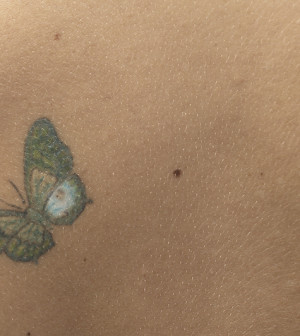- Skip Storing This Everyday Product in the Fridge Door
- Green Tea + B3 Pairing May Boost Brain Health
- Navigating Your Midlife Crisis: Embracing New Possibilities
- City Raccoons Showing Signs of Domestication
- Mapping the Exposome: Science Broadens Focus to Environmental Disease Triggers
- One Week Less on Social Media Linked to Better Mental Health
- Your Brain Changes in Stages as You Age, Study Finds
- Some Suicide Victims Show No Typical Warning Signs, Study Finds
- ByHeart Formula Faces Lawsuits After Babies Sickened With Botulism
- Switch to Vegan Diet Could Cut Your Greenhouse Gas Emissions in Half
Preservative in Baby Wipes Linked to Rashes in Some Children


Researchers say they have pinpointed a preservative found in many popular wet wipes and baby wipes as the cause of allergic skin reactions in some children.
Reports of reactions have ranged from disfiguring patches to crusting, swelling, blistering and tiny cracks in the mouth, cheek, hands and/or buttocks of young patients.
The six cases these researchers investigated took place in the United States between March 2011 and January 2013. All involved two brands of wipes: Huggies and Cottenelle. The children were between the ages of 3 and 8, and none were wearing diapers.
Both brands, which are manufactured by Kimberly-Clark Corp., contain a well-known preservative called methylisothiazolinone (MI), a chemical that investigators believe is found in roughly half of all the wipes sold in the United States.
A Kimberly-Clark official said the company is taking steps to address the problem.
“While our wipe products remain safe for use, we recognize that recent studies have raised concerns about the use of MI as a preservative ingredient,” said company spokesman Bob Brand.
“We have been evaluating alternative preservative options over the past few years, and are now ready to confirm that, beginning this month, Kimberly-Clark will start introducing new wet wipes that are MI-free across its entire product range in the U.S., Canada, Europe and other global markets,” Brand added.
In the latest cases, standard antibiotic and corticosteroid treatments were initially given for what doctors had incorrectly diagnosed as one of a number of common skin conditions. The treatments didn’t work, but when the children stopped using the wipes, their skin recovered quickly.
This fresh cluster of cases among American children comes on the heels of six such cases reported in 2010 among adult residents of Belgium, all of whom had been using moist toilet paper containing the same preservative.
“This preservative is not new,” said study author Dr. Mary Wu Chang. “But it was used as a combination preservative for many years. To try to minimize allergic reactions, it is now being used as a single preservative but in higher concentrations, and now people are developing allergic rashes to the new formulation.
“The rashes were proven to be caused by the preservative by patch testing, a method of putting various substances on the skin using a sticker-like sample, and seeing how the skin reacts,” she added.
“The offending preservative was then found in the brands of the wipes that were used,” Chang explained. “Most importantly, the rashes immediately resolved within days after I instructed the parents to stop using the wipes, and these were rashes that were going on for many weeks to many months.”
Chang, an associate clinical professor of dermatology and pediatrics at the University of Connecticut (UC) School of Medicine in Farmington, reported her findings with study co-author and UC medical student Radhika Nakrani in the Jan. 13 online issue of Pediatrics.
According to the study, the preservative had been used in a wide range of personal care, cosmetic and household consumer products as part of a combination formula that paired it with another preservative called methylchloroisothiazolinone, or MCI.
Over time, the combination was identified as a clear cause of allergic skin reactions, prompting regulations cutting back on its use, the researchers said.
As a result, manufacturers turned to MI as a standalone preservative, based on the belief that it was less likely to cause an allergic reaction.
The problem: the new regulations allowed MI concentrations to rise dramatically, from 3.7 parts per million to as much as 100 parts per million, the study authors said.
“More and more people are using these products and becoming sensitized to the preservative,” said Chang, who added that “with increased marketing and popularity of disposable wet wipes for all ages, there will likely be more people developing allergies to the preservative.”
What are parents to do? “People have to learn how to read labels, and be aware of this preservative,” she advised.
Chang did acknowledge that MI is not the only ingredient in these products that can trigger an allergic reaction.
“There is not one consensus on preservative use in wipes, nor in other personal care products. It’s up to the manufacturer which preservative is used, in accordance with regulations,” Chang said. “Almost all cosmetics and personal care products will have some type of preservative in them, to ensure stability and shelf life.”
One expert said the findings should not send parents into a panic.
“We’re talking about a very small proportion of people who will have a problem with MI,” said Dr. Carla Davis, director of the food allergy program at Texas Children’s Hospital in Houston. “So, really, parents should be comfortable using wipes until or unless their child develops a rash that doesn’t resolve in the regular manner. But if that happens and the rash is persistent, then the wipes could be a problem and testing should be pursued by a dermatologist.”
More information
For more information on contact dermatitis, visit the U.S. National Library of Medicine.
Source: HealthDay
Copyright © 2025 HealthDay. All rights reserved.










